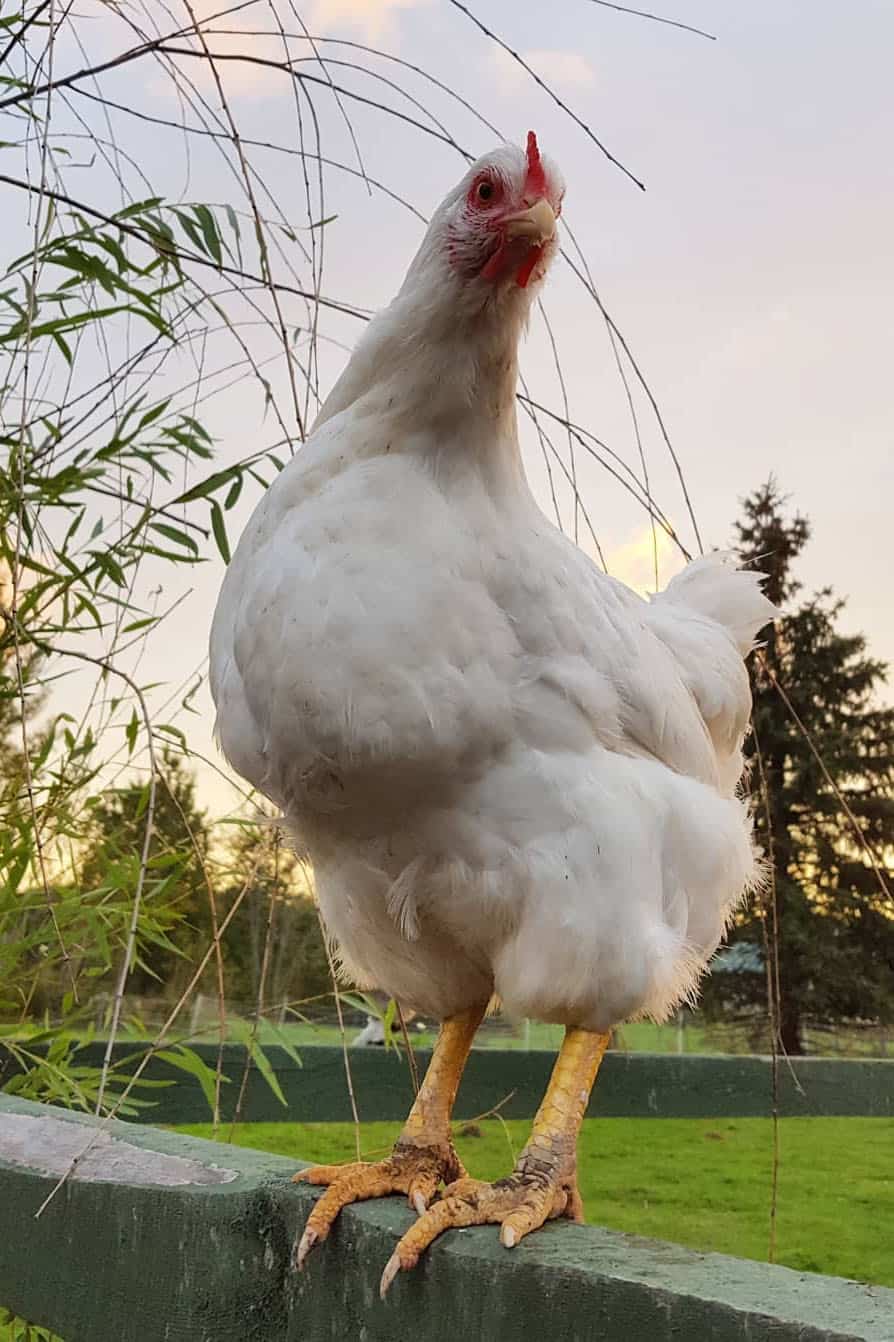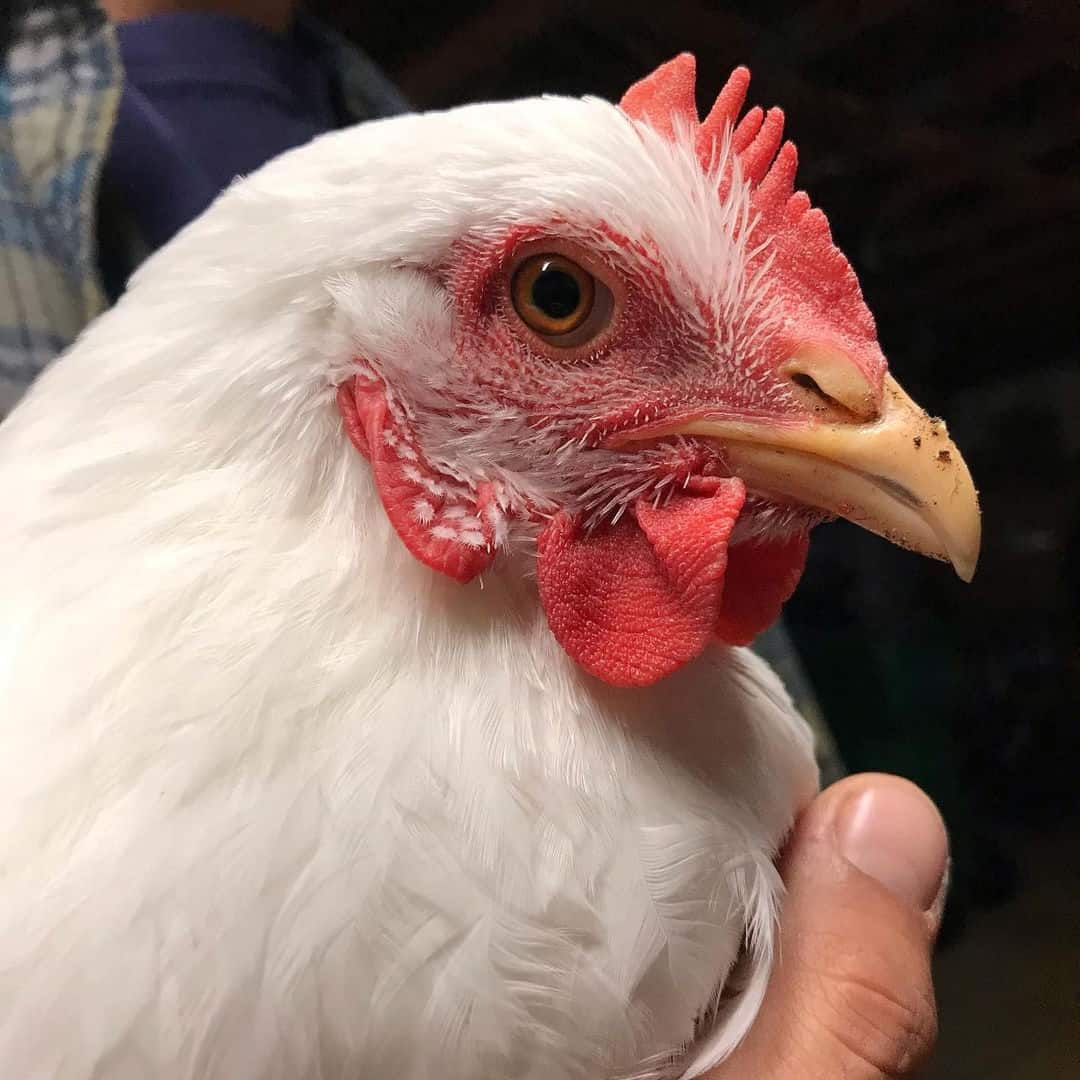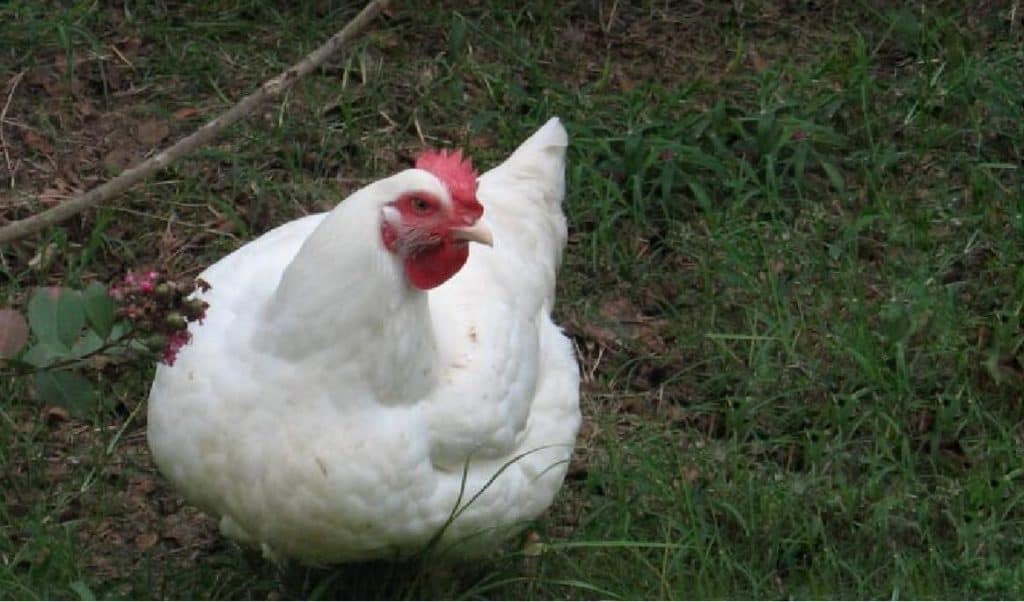The White Rock chicken is one that has been a part of American barnyards for over a century. It is considered a “dual-purpose” chicken, meaning that it is not only a great laying hen, but the White Rock is known for its tender, juicy meat. Furthermore, the White Rock is known for its easygoing temperament. This makes them a perfect backyard chicken breed!
History of White Rock Chickens

The White Rock Chicken was first developed and introduced into livestock in the late nineteenth century. They are a variety of the Plymouth Rock chicken, but, as this particular strain was developed in a town named White Rock, the breed took the name of their place of origin.
The White Rock chicken is both docile and hardy. They are able to adapt to both warm and cooler climates, and, as a dual purpose chicken, they are sought after for their ability to produce quality eggs and high-quality meat. The White Rock is typically used in commercial poultry production due to these factors.
The White Rock was most definitely developed with purpose. In fact, much care was put into the selection of breeds that eventually made the White Rock chicken breed.
It is likely that the breed is so hardy to colder climates because of this careful selection, and also to the fact that the breed was developed in a cooler region of the United States. Aside from being able to acclimate themselves to any environment, the White Rock is also great at egg production and providing quality meat.
White Rock Chicken Overview
| Information | White Rock Chicken |
|---|---|
| Purpose | Dual Purpose |
| Egg Color | Brown |
| Egg Size | Large |
| Egg Production | 280-320 per year |
| Broody | Occasionally |
| Heat Tolerance | Yes |
| Cold Tolerance | Yes |
| Comb Type | Single |
| Chicken Skin Color | White |
| Life Span | 5-8 years |
| Adult Weight (hen) | 6-7 lbs |
| Adult Weight (rooster) | 8-9 lbs |
| Backyard Friendly | 4/5 |
White Rock Chicken Breed Standard
The White Rock chicken will begin life with yellow combs that will eventually turn red. In fact, once the comb of a White Rock starts to turn red, hens will begin laying (and their production rate is great!) Their beaks will be yellow and their eyes will be an orange-red color.
The White Rocks are considered to be a part of the “barred rock” family of chickens. They will be white in color, and their feathering pattern is often described as “fluffy.” They are not just feathers, however.
The average adult White Rock is approximately eight pounds at maturity. Many standard keepers describe this as the typical size of all chickens, but, in truth, the White Rock chicken is actually bigger than other standard-sized chickens.
Hens will weigh closer to seven pounds. Roosters may weigh slightly over eight pounds.
The White Rock is so “fluffy” because of an undercoat of feathers. This typically a seasonal trait of the White Rock, and once winter is over, the White Rock may lose a bit of the fluffy appearance this downy undercoat provides.
The White Rock, even though it is a part of the “barred rock” group of chickens, will always be a snowy white and there is no coloring in their feathers.
The wattle is red as well.
Personality and Temperament
While some chickens seem to tolerate their human caregivers (and some would rather not interact with humans at all), the White Rock is a chicken breed that actually enjoys companionship with people. The White Rock can be picked up and they tolerate being held by humans rather well (as opposed to other chicken breeds that may be flighty or nervous when handled).
Only rarely will one hear of a White Rock chicken that pecks at its human handlers, but, one word of caution – if you want your White Rock to be a friendly, sweet chicken, begin handling her at a young age. The more the White Rock is socialized to people, the better she will be at enjoying human interaction.
Ironically, White Rock is able to be trained. Those who raise a flock of White Rock chickens from hatching relate that their chickens will learn how to come when called, and they will look forward to interacting with humans (for more than just food purposes, too!). In fact, the White Rock often becomes attached to their human caregivers – a great personality trait indeed!

Egg Laying
Keep in mind that the White Rock chicken is hailed for its propensity to produce high quality eggs. In fact, the White Rock may lay up to as many as 280 eggs per year!
White Rock is one of the most commonly used chicken breeds for commercial egg production. Typically, the White Rock hen will lay one egg (large in size) during every twenty-four hour period. They begin to lay eggs at maturity, and handlers can recognize this by watching when the comb of the White Rock hen turns from yellow to red.
You may see them appear to squat as if they feel the pressure. Hens will also naturally begin to spend time in the nesting boxes of the coop when they are getting ready to begin producing eggs regularly.

Hens begin laying eggs at approximately five months of age (again, the comb and wattle of the mature hen will be red, so you can look at this outward sign to determine whether your hen is about to start laying eggs regularly). White Rock hens do not stop producing eggs until they are approximately five years old, with a noticeable slow-down in production around age four.
White Rock hens produce eggs year-round.
Experts report that as long as your hen is “happy,” you can expect egg production every twenty-four hours.
Health Issues and Care of the White Rock chicken

The White Rock chicken is typically a very hardy and healthy bird. Along with their propensity for egg production and high-quality meat, this characteristic makes the White Rock an easy choice for commercial chicken production.
The White Rock, when properly cared for, typically lives for up to eight years. However, some reports show that there are White Rocks that live up to twelve years. Again, all this is controlled by factors such as the right care for a chicken.
The White Rock may experience an infestation of lice or other poultry parasites. This is the most common health issue the White Rock will have. Regular observation will show the presence of lice or other parasites that can easily be treated if you see them on your White Rock. Remember to treat any of these chicken parasites as early as possible for the best outcome.
Also, experts recommend feeding the White Rock a small dose of apple cider vinegar in order to prevent some of those parasites that can be rather pesky to your chicken.
White Rock chickens won’t usually die from a parasitic infestation, but, if left untreated, the chicken may fall ill from some other health ailment that is more serious than simple parasites.
White Rock chickens are not typically susceptible to warm or cool weather, but they are sensitive to extreme temperatures if their handlers do not make some accommodations. Most of the time, this is simply a well-built chicken coop that provides protection from the elements.
Tips for Raising the White Rock Chicken

The White Rock chicken is one that is easy for even first-time breeders to raise successfully. They do well in a variety of temperatures, although they will need some special care during extreme temperatures (this goes for most any livestock animal).
The White Rock is highly adaptable. Previously we mentioned the fluffy undercoat of feathers – this undercoat will not manifest itself in warmer climates. However, in northern climates, the White Rock will produce the aforementioned undercoat to protect itself from frostbite.
The White Rock will need a well-built coop that protects it from the elements. As hens reach twenty weeks of age, they will need nesting boxes. They need a coop that allows for ventilation but isn’t drafty.
The coop should be a welcoming place for both roosters and hens. You’ll also need to provide a foraging area for the White Rock as they do enjoy getting out and hunting for seeds and other delicacies (worms, anyone?).

The White Rock will need perches inside the coop as well. They love to roost inside their coop, and this protects them not only from the elements but from a number of predators as well.
The White Rock should be “socialized” at an early age. In fact, the more you can handle White Rock chicks when they are, well, chicks, they will be more apt to interact with you as they grow older.
As previously stated, the White Rock has a tendency to bond to its handlers (caregivers), so the more you can interact with the White Rock chick, the stronger the bond you will experience as the chick grows into an adult chicken.
The White Rock does not require much in the way of care. Provide them with a coop, a place to roost and lay eggs safely, and a place to forage, and you’ll have a happy White Rock Chicken!
Summary
The White Rock chicken is a hardy and healthy bird that is enjoyed by many poultry enthusiasts across the United States. In fact, it is a popular chicken all over the world. It’s dual purpose – the ability to produce great eggs and high-quality meat – makes it a great choice for commercial production. Backyard chicken tenders enjoy the easygoing bird as well.


Joseph Hudson has been raising chickens for over 15 years. In 2018, he completed the Agriculture & Natural Resources program at Mt. San Antonio College. He currently raises over 1400 chickens on his 7.5-hectare farm. He keeps sharing his experience on raising healthy and happy chickens on Chicken Scratch The Foundry.








I bought 5 pullets and 1 marked cockerel hatched 4/28/21. 20 weeks is coming up and the cockerel has no signs of hackles or any other signs. Except for that beak to beak spar thing they do, and only with one of the hens. Some hens comb and wattle just now starting to turn red. Cockerel comb always seem to be red compared to pullets. Maybe he is just a late bloomer???